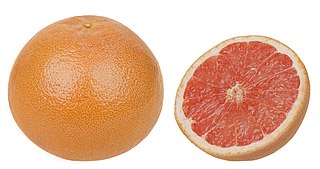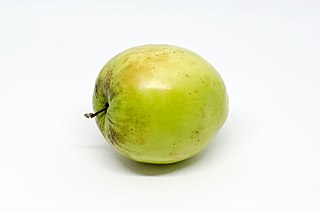
Kumquats are a group of small fruit-bearing trees in the flowering plant family Rutaceae. They were previously classified as forming the now-historical genus Fortunella, or placed within Citrus sensu lato.

Mangoes are juicy stone fruit (drupe) from numerous species of tropical trees belonging to the flowering plant genus Mangifera, cultivated mostly for their edible fruit.

The grapefruit is a subtropical citrus tree known for its relatively large sour to semi-sweet, somewhat bitter fruit. Grapefruit is a citrus hybrid originating in Barbados as an accidental cross between two introduced species – sweet orange, and pomelo – both of which were introduced from Asia in the seventeenth century. When found, it was nicknamed the "forbidden fruit". Frequently, it is misidentified as the very similar parent species, pomelo.

Carambola, or star fruit, is the fruit of Averrhoa carambola, a species of tree native to Indonesia, the Philippines, and throughout Malaysia. The fruit is commonly consumed throughout Southeast Asia, the South Pacific, Micronesia, and parts of East Asia. The tree is cultivated throughout tropical areas.

A fruit tree is a tree which bears fruit that is consumed or used by humans and some animals — all trees that are flowering plants produce fruit, which are the ripened ovaries of flowers containing one or more seeds. In horticultural usage, the term 'fruit tree' is limited to those that provide fruit for human food. Types of fruits are described and defined elsewhere, but would include "fruit" in a culinary sense, as well as some nut-bearing trees, such as walnuts.

Citrus limetta, alternatively considered to be a cultivar of Citrus limon, C. limon 'Limetta', is a species of citrus, commonly known as mousambi, musambi, sweet lime, sweet lemon, and sweet limetta, it is a member of the sweet lemons. It is a cross between the citron and a bitter orange.

Ziziphus mauritiana, also known as Chinese date, ber, Chinee apple, jujube, Indian plum, Regi pandu, Indian jujube, dunks and masau, is a tropical fruit tree species belonging to the family Rhamnaceae.

Lansium parasiticum, commonly known in English as langsat or lanzones, is a species of tree in the Mahogany family with commercially cultivated edible fruits. The species is native to Southeast Asia.

Dekopon (デコポン) is a seedless and sweet variety of mandarin orange.

Pouteria caimito, the abiu, is a tropical fruit tree originated in the Amazonian region of South America. It grows to an average of 33 feet (10 m) high, and can grow as high as 116 feet (35 m) under good conditions. Its fruits' shape varies from round to oval, pointed at the distal end. When ripe, it has smooth, bright yellow skin and has one to four ovate seeds. The inside of the fruit is translucent and white. It has a creamy and jelly-like texture and its taste is similar to the sapodilla — a sweet caramel custard. The abiu tree is part of the family Sapotaceae and is very similar in appearance to the canistel.

The orange is the fruit of the citrus species Citrus × sinensis in the family Rutaceae, native to China. It is also called sweet orange, to distinguish it from the related Citrus × aurantium, referred to as bitter orange. The sweet orange reproduces asexually ; varieties of sweet orange arise through mutations.

Sweet lemon and sweet lime refer to many citrus hybrids that contain low acid pulp and juice. They are hybrids often similar to non-sweet lemons or limes, but with less citron parentage. Sweet limes and lemons are not sharply separated:
The sweet lime, Citrus limettioides Tan., is often confused with the sweet lemon, C. limetta Tan., which, in certain areas, is referred to as "sweet lime". In some of the literature, it is impossible to tell which fruit is under discussion.

The ponderosa lemon is a citrus hybrid of a pomelo and a citron. It is not the same as the 'Yuma Ponderosa' lemon pomello hybrid, that is used as citrus rootstock.

Psidium guajava, the common guava, yellow guava, or lemon guava is an evergreen shrub or small tree native to the Caribbean, Central America and South America. It is easily pollinated by insects; in culture, mainly by the common honey bee, Apis mellifera.

The cam sành or King orange is a citrus hybrid originating in Vietnam.

The lemon, Citrus limon (L.) Osbeck, is a species of small evergreen tree in the flowering plant family Rutaceae, native to South Asia, primarily North eastern India.

Hyuganatsu is a citrus fruit and plant grown in Japan. The name comes from Hyūga, the ancient name of Miyazaki Prefecture in Kyushu, where the citrus is said to have originated, while "natsu" (夏) means summer. Hyūganatsu grown outside Kyushu are sometimes shipped under different names such as Konatsu (小夏), Tosakonatsu (土佐小夏), or New Summer Orange (ニューサマーオレンジ).

Citrus taxonomy refers to the botanical classification of the species, varieties, cultivars, and graft hybrids within the genus Citrus and related genera, found in cultivation and in the wild.

























